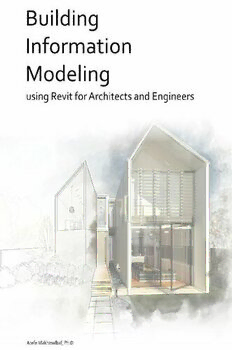Table Of ContentBuilding Information Modeling using Revit for Architects
and Engineers
Building Information Modeling
using Revit for Architects and
Engineers
ATEFE MAKHMALBAF
ASHLEY FOSTER
MAVS OPEN PRESS
ARLINGTON
Building Information Modeling using Revit for Architects and Engineers by Atefe Makhmalbaf is licensed
under a Creative Commons Attribution 4.0 International License, except where otherwise noted.
Contents
About the Publisher vii
Mavs Open Press
About This Project ix
Acknowledgments xi
Chapter 1: Revit Interface 1
Chapter 2: Walls, Curtain Walls, Windows and Doors 17
Chapter 3: Floors, Roofs and Ceilings 46
Chapter 4: Stairs, Railings and Ramps 68
Chapter 5: Adding - Modifying Families 87
Chapter 6: Massing - Conceptual Mass 106
Chapter 7: Model In-Place 114
Chapter 8: Schematic Design and Room & Color Fill Plans 132
Chapter 9: Materials, Visualization and Rendering 141
Chapter 10: Details and Annotations 155
Chapter 11: Workflow | Worksharing 169
Chapter 12: Schedules and Project Phasing 178
Chapter 13: Drawing Sets and Construction Documents 186
Chapter 14: Site Modeling 191
Chapter 15: MEP - Fire Protection and Fabrication Parts 196
Chapter 16: Structural Systems 216
Links by Chapter 231
About the Publisher
MAVS OPEN PRESS
About Mavs Open Press
Creation of this resource was supported by Mavs Open Press, operated by the University
of Texas at Arlington Libraries (UTA Libraries). Mavs Open Press offers no-cost services
for UTA faculty, staff, and students who wish to openly publish their scholarship. The
Libraries’ program provides human and technological resources that empower our
communities to publish new open access journals, to convert traditional print journals
to open access publications, and to create or adapt open educational resources (OER).
Our resources are openly licensed using Creative Commons licenses and are offered in
various e-book formats free of charge, which can be downloaded from the Mavs Open
Press OER catalog. Optional print copies of this text may be available through the UTA
Bookstore or can be purchased directly from XanEdu, Mavs Open Press’ exclusive print
provider and distributor.
About OER
OER are free teaching and learning materials that are licensed to allow for revision and
reuse. They can be fully self-contained textbooks, videos, quizzes, learning modules, and
more. OER are distinct from public resources in that they permit others to use, copy,
distribute, modify, or reuse the content. The legal permission to modify and customize
OER to meet the specific learning objectives of a particular course make them a useful
pedagogical tool.
About Pressbooks
Pressbooks is an open source, web-based authoring tool based on WordPress, and it
is the primary tool that Mavs Open Press uses to create and adapt course materials.
Pressbooks should not be used with Internet Explorer. The following browsers are best
to use with Pressbooks:
• Firefox
• Chrome
About the Publisher | vii
• Safari
• Edge
Contact Us
Information about open education at UTA is available online. Contact us at oer@uta.edu
for other inquires related to UTA Libraries publishing services.
viii | About the Publisher
About This Project
About the Book
This book is geared towards users who have no Revit background. It starts with Revit
basics such as how to create walls, floors, roof, but it also covers more advanced topics
such as creating a complex object, preparing construction documents, and modeling
mechanical and structural systems.
This book is an open education platform for Architecture and Civil Engineering
students to learn Revit and provides students with adequate, coherent, consistent, and
cost-saving educational resources. It includes both text and video of each chapter to
help students have access to both step-by-step written instructions and videos of each
lesson because software instructions are mostly narratives and difficult for students to
visualize the procedures and follow the instructions.
BIM is one of the most recent developments influencing the architecture,
engineering, and construction (AEC) industry. BIM provides the opportunity to improve
poor communication and information sharing among building owners, architects,
engineers, builders, and public authorities. It enhances collaboration among project
teams and improves AEC performance by decreasing project cost, increasing
productivity and quality, and reducing project delivery time. Students pursuing a
degree in a related field should gain knowledge and skills about BIM and its tools.
The book is composed of 15 chapters covering various topics. Each chapter starts with
the basics of creating elements and builds on students’ previous knowledge and takes
them further to develop BIM modeling skills using Revit. Each chapter presents a mix of
written instructions, various activities, and videos to help students with various learning
needs. Completing each chapter is the same as completing an assignment and skills
developed can be used to work on a class project defined by the course instructor or
found online.
About the Contributors
Author
Dr. Atefe Makhmalbaf is an assistant professor at School of Architecture. She teaches
building information modeling and energy-conscious building design. Her research
includes performance-based building design, multi-objective building operation
About This Project | ix

